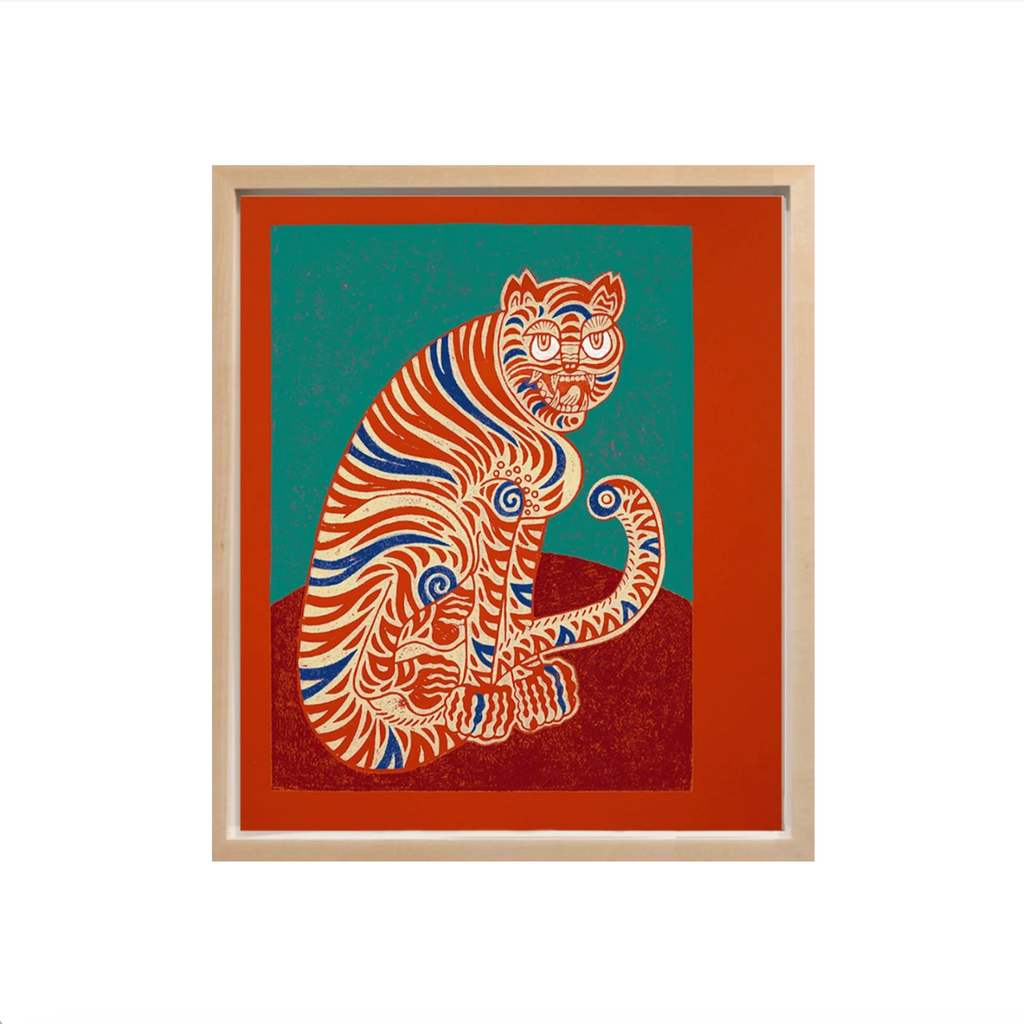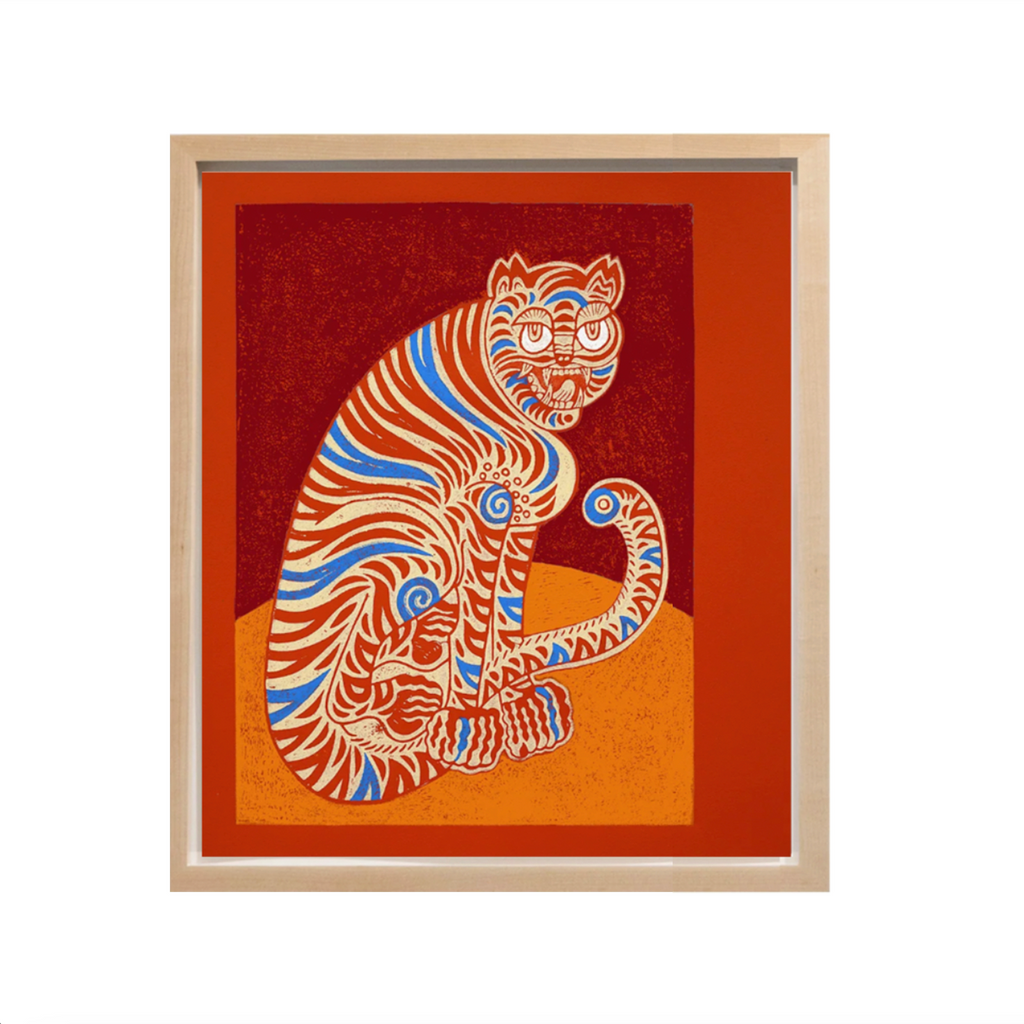On Kour Pour
Kour Pour (b. 1987, Exeter, England) is a British+Iranian+American artist based in Los Angeles investigating his experience of living between cultures. As the Year of the Tiger comes to a close, in celebration of the upcoming Spring Festival and Chinese Lunar New Year on Sunday, January 22nd, we talked with the artist to learn more about the inspiration behind this special set of hand-finished block prints, available for sale exclusively through artforchange.com.
Kour Pour, Coy Tiger (Teal & Maroon), 2022; Hand-Embellished, Signed, and Numbered Limited Edition Print
- Regular
- from $1,300.00
- Sale
- from $1,300.00
- Regular
-
- Unit Price
- per
The Spring Festival is a celebration marking the end of winter and New Year in the Lunar Calendar. Usually falling in January or February, the festival represents the desire for new life and is marked with a number of stories and celebrations. A central myth of the New Year’s celebrations is the celestial race between each of the animals of the zodiac, determining the order of the years. The tiger represented 2022, presenting us with a year marked by bravery, strength and exorcizing evil and malice from the environment.
Pour explores the Tiger throughout this practice, an auspicious and protective symbol that appears in the foundational mythologies of Chinese, Korean, and Japanese cultures. Pour’s tiger paintings take on personally as well as universally redolent themes of finding peace and power in the perceived ambiguity of expressing identity in an increasingly multicultural world. Reflecting on a 13th century Chinese tiger painting in the Metropolitan Museum of Art collection that was eventually reattributed as a 16th/17th century Korean or Japanese copy, Pour shares:
Kour Pour, Coy Tiger (Maroon & Gold), 2022; Hand-Embellished, Signed, and Numbered Limited Edition Print
- Regular
-
from $1,300.00SOLD OUT - Sale
-
from $1,300.00SOLD OUT - Regular
-
- Unit Price
- per
“The slipperiness and confusion on the origins of the images really resonated with me. In the same sense that people ask ‘where are you from… no, where are you really from?’ I felt connected to the tigers and how our identity can take on different forms depending on the environment we find ourselves in.”
Kour Pour, Coy Tiger (Gold & Teal), 2022; Hand-Embellished, Signed, and Numbered Limited Edition Print
- Regular
- from $1,300.00
- Sale
- from $1,300.00
- Regular
-
- Unit Price
- per
Tiger paintings have often been difficult to place cleanly within art history. The famous Korean Minhwa tigers are more graphic and exaggerated than Chinese paintings that are more naturalistic in style, yet they borrow compositions and poses from the older Chinese scrolls. The artists who made many of the early Japanese works that include tigers clearly looked towards Korean and Chinese paintings as tigers did not inhabit the island. In one painting, there can be several historical and cultural layers that trace the movement of the tiger image throughout Asia.
“They may look or sound different, but many of our stories and mythologies have very similar origins. People respond to the same themes over time.” — Kour Pour
Pour’s tigers prioritize global histories over purely western perspectives and blend together different time periods and styles in fresh, new ways. Looking to the histories of reproduction, from early East Asian prints and paintings through to Pop Art, the artist builds his practice around intersections—of life, love, culture, and more—into an active and present body of work that connects historical conversations with the contemporary world.
Kour Pour, Coy Tiger (Blue & Navy), 2022; Hand-Embellished, Signed, and Numbered Limited Edition Print
- Regular
- from $1,300.00
- Sale
- from $1,300.00
- Regular
-
- Unit Price
- per
Kour Pour’s Coy Tigers are on view through January 31, 2023 at Ralph Pucci International in Miami as part of our exhibition co-curated with Galerie magazine in celebration of their Emerging Artists Issue. Reach out to hello@artforchange.com for more information and shop the full series at this link.









